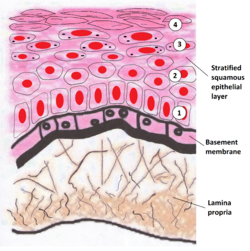
Back صفيحة مخصوصة Arabic Lamina propria Azerbaijani Lamina propria BS Làmina pròpia Catalan Lamina propria German Lámina propia Spanish Lamina propria French שכבת הרירית המיוחדת HE Lamina propria Italian 粘膜固有層 Japanese
| Lamina propria | |
|---|---|
 | |
| Details | |
| Part of | Mucosa |
| Identifiers | |
| Latin | lamina propria mucosæ |
| FMA | 62517 |
| Anatomical terminology | |
The lamina propria is a thin layer of connective tissue that forms part of the moist linings known as mucous membranes or mucosae, which line various tubes in the body, such as the respiratory tract, the gastrointestinal tract, and the urogenital tract.
The lamina propria is a thin layer of loose (areolar) connective tissue, which lies beneath the epithelium, and together with the epithelium and basement membrane constitutes the mucosa. As its Latin name indicates, it is a characteristic component of the mucosa, or the mucosa's "own special layer." Thus, the term mucosa or mucous membrane refers to the combination of the epithelium and the lamina propria.[1]
The connective tissue of the lamina propria is loose and rich in cells. The cells of the lamina propria are variable and can include fibroblasts, lymphocytes, plasma cells, macrophages, eosinophilic leukocytes, and mast cells.[2] It provides support and nutrition to the epithelium, as well as the means to bind to the underlying tissue. Irregularities in the connective tissue surface, such as papillae found in the tongue, increase the area of contact of the lamina propria and the epithelium.[3]
- ^ Burkitt, H. George; Young, Barbara; Heath, John W., eds. (1993). Wheater's Functional Histology (3rd ed.). Churchill Livingstone. ISBN 978-0-443-04691-9.[page needed]
- ^ Slomianka, Lutz (2009). "Blue Histology-Gastrointestinal Tract". The University of Western Australia.
- ^ Mescher, Anthony (2009). Junqueira's Basic Histology: Text & Atlas (12th ed.). McGraw Hill Professional. ISBN 978-0-07-171475-4.[page needed]
© MMXXIII Rich X Search. We shall prevail. All rights reserved. Rich X Search